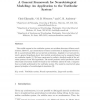Free Online Productivity Tools
i2Speak
i2Symbol
i2OCR
iTex2Img
iWeb2Print
iWeb2Shot
i2Type
iPdf2Split
iPdf2Merge
i2Bopomofo
i2Arabic
i2Style
i2Image
i2PDF
iLatex2Rtf
Sci2ools
78
Voted
IJON
2002
2002
A general framework for neurobiological modeling: an application to the vestibular system
The otolith organs in the vestibular system are excellent detectors of linear accelerations. However, any measurement of linear acceleration is ambiguous between a tilt in a gravitational field and an inertial acceleration. Angelaki et al. have put forward a general hypothesis about how inertial accelerations can be computed based on vestibular signals [1]. We have constructed a realistic, detailed model of the relevant systems to test this hypothesis. The model produces useful predictions about what kinds of neurons should be found in the vestibular nucleus if such a computation is actually performed in the vestibular system. The model is constructed using general principles of neurobiological simulation [2]. Key words: Vestibular system; Neural representation; Large-scale models.
Related Content
| Added | 22 Dec 2010 |
| Updated | 22 Dec 2010 |
| Type | Journal |
| Year | 2002 |
| Where | IJON |
| Authors | Chris Eliasmith, M. Brandon Westover, Charles H. Anderson |
Comments (0)

